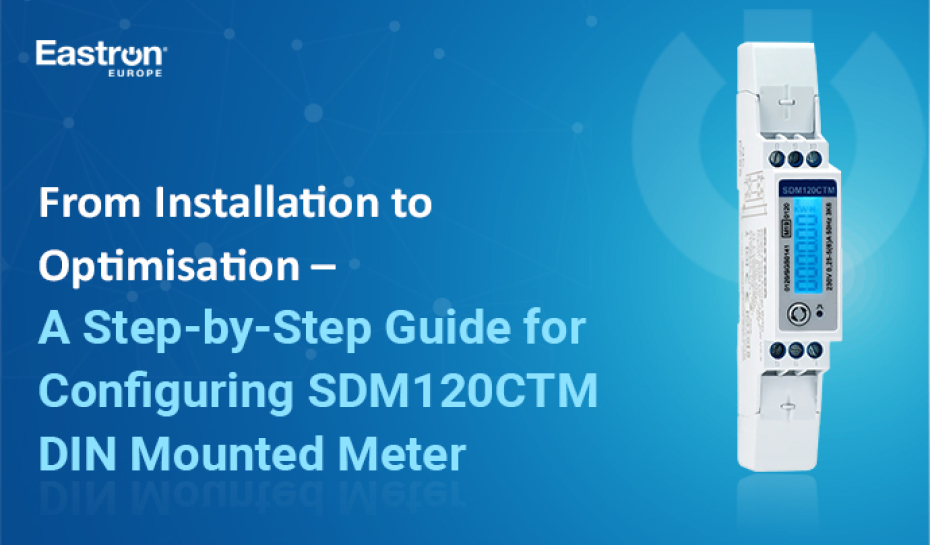
From Installation to Optimisation – A Step-by-Step Guide for Configuring SDM120CTM DIN Mounted Meter
Advanced electrical meters offer numerous advantages over traditional dial gauges. They are preferred for their enhanced reliability, durability, accuracy, and diagnostic capabilities. For instance, DIN Rail meters, mounted on standard rails featuring a compact design, offer precise monitoring abilities.
Single-phase and three-phase DIN Rail meters are vital in industrial settings. With easy installation and robust construction, they excel in supporting structures without sacrificing performance. Hence, these meters are essential for various applications, including energy measurement in large buildings and power management in enterprises.
That said, poor device installation and configuration can prevent the same from functioning correctly. And the chances of the same electrical gadget getting damaged from the wrong installation remain high.
How to Install DIN Rail Power Meters – Things to Consider
When installing DIN Rail mounted meters, several factors should be considered to ensure proper functionality, accuracy, and safety. These factors, at the time of the installation process, can help ensure the reliable operation, accuracy, and protection of the mounted meters in industrial or commercial environments.
- Location and Environment
- Mounting Surface
- Electrical Wiring
- Clearances and Accessibility
- Orientation and Alignment
- Calibration and Configuration
- Compatibility and Integration
- Regulatory Compliance
- Labeling and Documentation
- Training and Expertise
Three Easy Steps for Installing a DIN Rail Meter
In industrial applications, Energy DIN Rail meters are used with high-value electrical systems, entailing reliable data collection and accurate monitoring of energy use over a long time. However, in the absence of comprehensive guidelines, even an expert in handling electrical devices can commit basic configuration errors during installation, leading to numerous problems.
Therefore, a simple step-by-step guide is provided here to help you understand how the installation of three-phase/single-phase DIN Rail mounted power meters is executed.
Three Easy Steps for Installing a DIN Rail meter, SDM120CTM:
Step 1: Input Voltage Reference
Start by connecting a voltage reference, which is supplied from a 1AMP fast blow fuse. Insert the live line into terminal 4 and the neutral into terminal 3.
Step 2: Connect Current Transformer (CT)
Next, connect the current transformer. Insert the white wire (S1) into terminal 1 and the black wire (S2) into terminal 2.
Step 3: Set CT Rate
Set the CT rate within the meter. Press and hold the button until "set" is displayed. Then, press and hold again until the CT values are shown. Use the button to scroll through the options until the desired rate is displayed. For example, if using a CT rated with a 200A input and 5A output, select 200 as the rate.
Kindly note:
Terminals 5, 6, and 7 are pulsed outputs.
Terminals 8, 9, and 10 are Modbus connections.
SDM120CTM, or the sub-distribution, single-phase DIN Rail meter with Modbus rs485 communication, is a low-cost remote monitoring device available with built-in connectivity and configured interface for programmable settings. The installation process is simple and frictionless, like the steps mentioned above.
Here is a sample demo video for your reference.
What Happens If DIN Rail Meters Were Installed Incorrectly?
Proper installation of DIN Rail meters is essential to ensure accurate measurements, electrical safety, and optimal performance within industrial or commercial environments. Therefore, an incorrect installation can hamper its overall performance, leading to several problems and challenges.
- Electrical Safety Risks
- Inaccurate Measurements
- Interference and Signal Disturbance
- Mechanical Instability
- Compromised Durability
- Regulatory Compliance Issues
- Difficulty in Maintenance and Troubleshooting
The Final Takeaway
Accurate installation of DIN Rail mounted meters is essential for achieving reliable electrical measurement, data integrity, operational efficiency, cost savings, regulatory compliance, and safety within industrial and commercial environments. Investing time and resources in proper installation practices ensures the long-term performance and effectiveness of metering systems.
